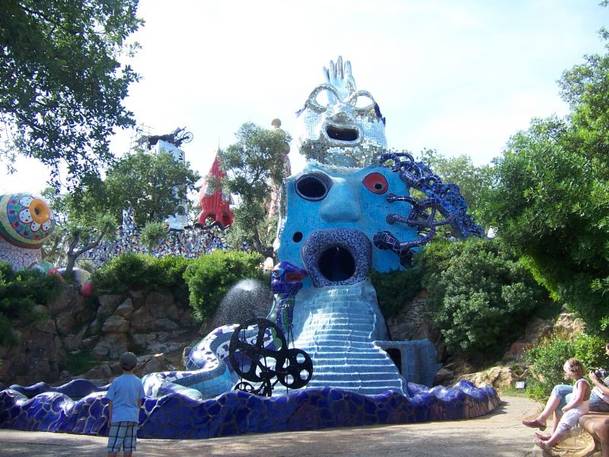


Reflections of color and light sparkle from intricately patterned glass, mirror, and ceramic mosaics. Otherworldy playful creatures provoke children to skip around gleefully. Hidden passages, curvy staircases, precarious balconies, and comfortable benches overlook falling water.
The carnivalesque retreat, Il Giardino dei Tarocchi (the Tarot Garden), made by Niki de Sainte Phalle, is strangely beautiful—and sometimes oddly suggestive of the grotestque. Together the peaceful space—inviting in its vibrancy as it is isolated geographically on an undeveloped stretch of hillside—evokes a migrant identity gently informed by an Italian artistic sensibility and an appreciation for the craft of skilled labor.
Niki de Sainte Phalle (née Catherine Marie-Agnès Fal de Sainte Phalle , 1930-2002) was born in France and lived part of her childhood in various U.S. cities (including Princeton, Boston, and New York). She moved to Italy in the 1970s, living within what would eventually become part of her Tarot Garden (in the province of Grosseto, in Tuscany). There she constructed over 22 sculptures, fountains, and installations covering a large hillside about 12 miles from the seaside. Towards the end of her life she moved to La Jolla, California, leading a rather secluded existence.
(In fact, I first became aware of her work while living in San Diego in the 1990s. The University of California, San Diego, has a Sun God sculpture that greets folks as they enter the campus, and San Diego’s Balboa Park is speckled by fantastical mosaic de Sainte Phalle animals, creating an intriguqing juxtaposition with the park’s more famous live animals in the ciy’s zoo.)
Back in Tuscany, de Sainte Phalle lived inside one of the most awe-inspiring pieces, the Imperatrice (the Empress), the bountiful, dark-skinned goddess that protects over much of the garden. The Imperatrice, as well as other parts of the Garden, so clearly evoke the neoclassical style common in Italian villas. By exaggerating the female body and adding so many layers of color and shape, de Sainte Phalle is able to overturn the basic elements of female objectification cemented into the more traditional examples of the female body-used-as-public art.
The artist was well connected to a number of European and American twentieth-century artists—a brief look at a bio starts to read like the index to a textbook on contemporary art. But in addition to connections to the likes of Salvador Dali, Robert Rauschenberg, Antonio Gaudi, and dozens of others, de Sainte Phalle spoke of other inspiratations.
At the entrance to the garden (opened to the public in 1998), she listed some of the Italian sites she found inspiring. She notes the Sistine Chapel and the Last Supper, as well as the fountains of Villa d’Este at Tivoli. She writes about the sacred aura of churches and other religious spaces and she describes the respect she has for their builders. (Such references remind me of Walter Benjamin’s descriptions of aura in religious art before the era of mechanical reproducibility, a sensibility de Sainte Phalle seems to want to evoke in her constructions.)
There are other spiritually suggestive places from which she seems to have gathered insight. For example, de Sainte Phalle was also influenced by at least one Italian American site-specific construction as—in 1962 she made a special trip to visit Simon (Sabato) Rodia’s Watts Towers [2]in Los Angeles. Her work’s reliance on mosaics, especially her use of broken pieces of tile as well as the grand scale of most of the sculptures, speaks to Rodia’s creation. (I am not doing justice to the other influences on her work but my focus here is to comment on how the hybrid nature of her work comes from both a migrant’s sensibility and an Italian one.)
As Teresa Fiore wrote in a review of Niki de Sainte Phalle’s work, the artist had a particular connection to Italy and Italian culture. Even though she had lived long portions of her life in France and the U.S., she came to see Italy as her second home. As Fiore argues: “ Il suo rapporto con l’Italia e` viscerale” (“her relationship to Italy is visceral”).
I visited the park with three children, all under 10. They were immediately comfortable in the space and yet it was nothing like a playground or other child-centered public construction I’ve seen. As Fiore concludes, this dual ability to be both playful and suggestive of something more is central to her style: "Perche` quest’artista ha sempre concepito l’arte come un gioco, ma un gioco serio” (“Because this artist has always conceptualized art as a game, but a serious game”). And it is within this see-saw between the joy of bright color and the layers of artistic history that the garden comes to represent the hybrid identity of an Italian migrant as well.
(Teresa Fiore's article was published in America Oggi, December 27, 1988. Thanks to the author for sending it to me.)
Source URL: http://ftp.iitaly.org/magazine/focus/life-people/article/la-ruota-della-fortuna-niki-de-sainte-phalles-take-italian-garden
Links
[1] http://ftp.iitaly.org/files/9876picture-3031245307200jpg
[2] http://www.wattstowers.us
[3] http://www.canino.info/inserti/tuscia/luoghi/bomarzo/storia.htm
[4] http://www.capalbio.it/DaVedere/Giardino%20di%20Tarocchi.htm
[5] http://www.nikidesaintphalle.com/